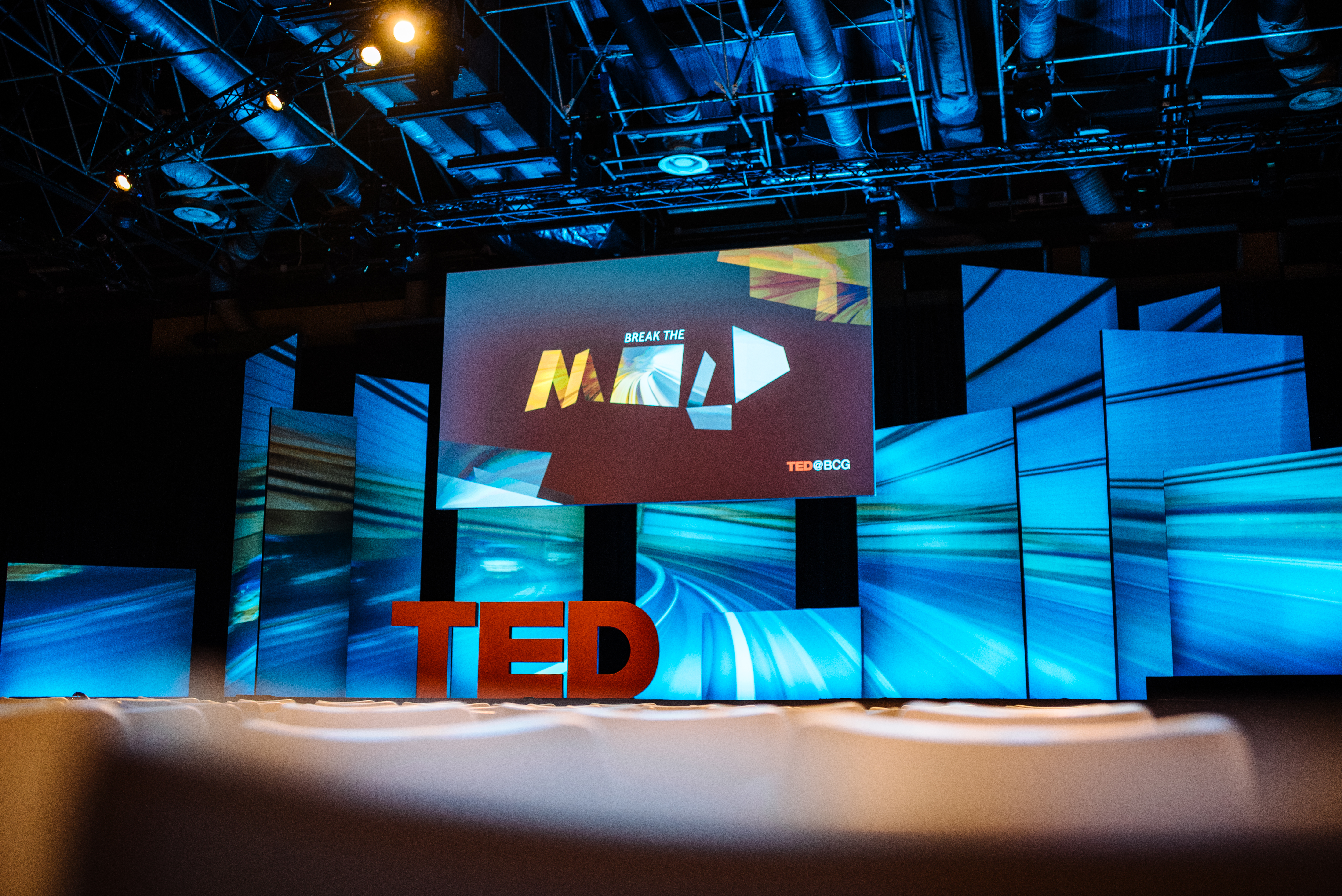
The main stage at TED@BCG at East End Studios, October 4, 2017, in Milan, Italy. Photo: Richard Hadley / TED
Complex times require a bold embrace of diversity and difference — and an ability to turn the unknown into an advantage. How can we tap into the unexpected?
For a fifth year, BCG has partnered with TED to bring experts in education, diversity, AI, biology and more to the stage to share ideas from the forefront of innovation. At this year’s TED@BCG — held on October 4, 2017, at East End Studios in Milan, Italy — 17 creators, leaders and innovators invited us to challenge preconceived ideas, grapple with real problems and open our minds to new ways of thinking.
After opening remarks from Rich Lesser, president and CEO of BCG, the talks of Session 1 …
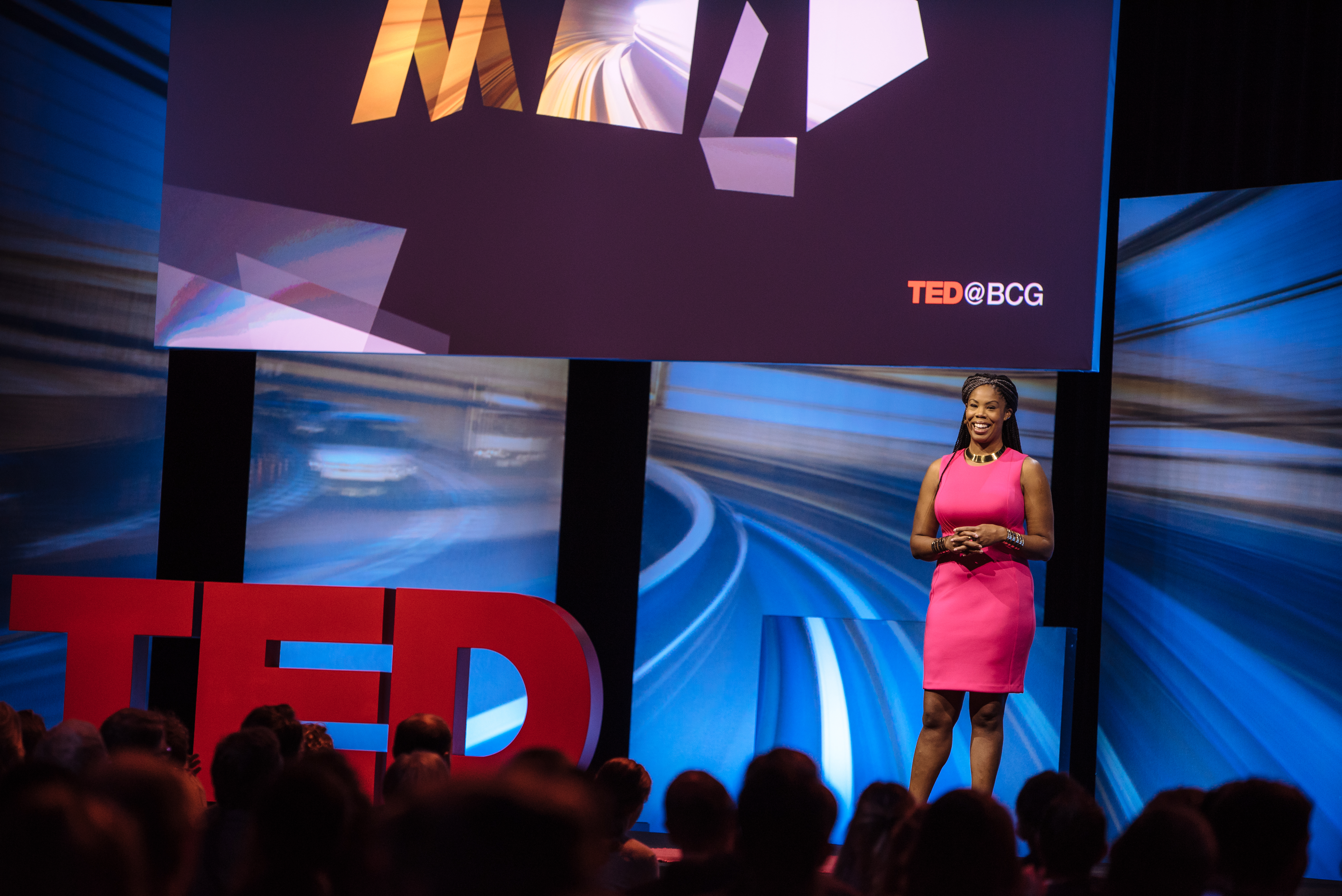
“Can I be myself today?” Erica Joy Baker speaks to the questions that underrepresented people may carry with them at work, creating anxiety their coworkers don’t feel. She took the stage at TED@BCG in Milan. Photo: Richard Hadley / TED
Bridging the “anxiety gap.” “Most of us come to work with a general set of questions and concerns: How do I make an impact? Will I meet my goals today?” says Erica Joy Baker, senior engineering manager at Patreon and an advocate for diversity and inclusion in tech. “But people from underrepresented groups have a different set of questions: Am I being paid fairly? How do I avoid sexual harassment? Can I be myself today?” Baker calls these ever-looming concerns the “anxiety gap” — a gulf created by the issues that she faces in the workplace as a woman of color, and one which she must always navigate before she can do the job she was hired for. She believes that companies need to recognize this phenomenon and make changes so all of their employees can thrive. For starters, she says, bosses should think about a time when they felt like an outsider and then figure out how to prevent their workers from experiencing those feelings on the job. They should make sure employees know they’re fairly compensated (by publishing salary ranges), and they should set up a safe, confidential method to report harassment. And all people, regardless of job title or pay grade, can speak up on behalf of coworkers who are struggling to traverse the anxiety gap. “Show them you are not only their ally,” Baker suggests, but that “you are their advocate and accomplice.”
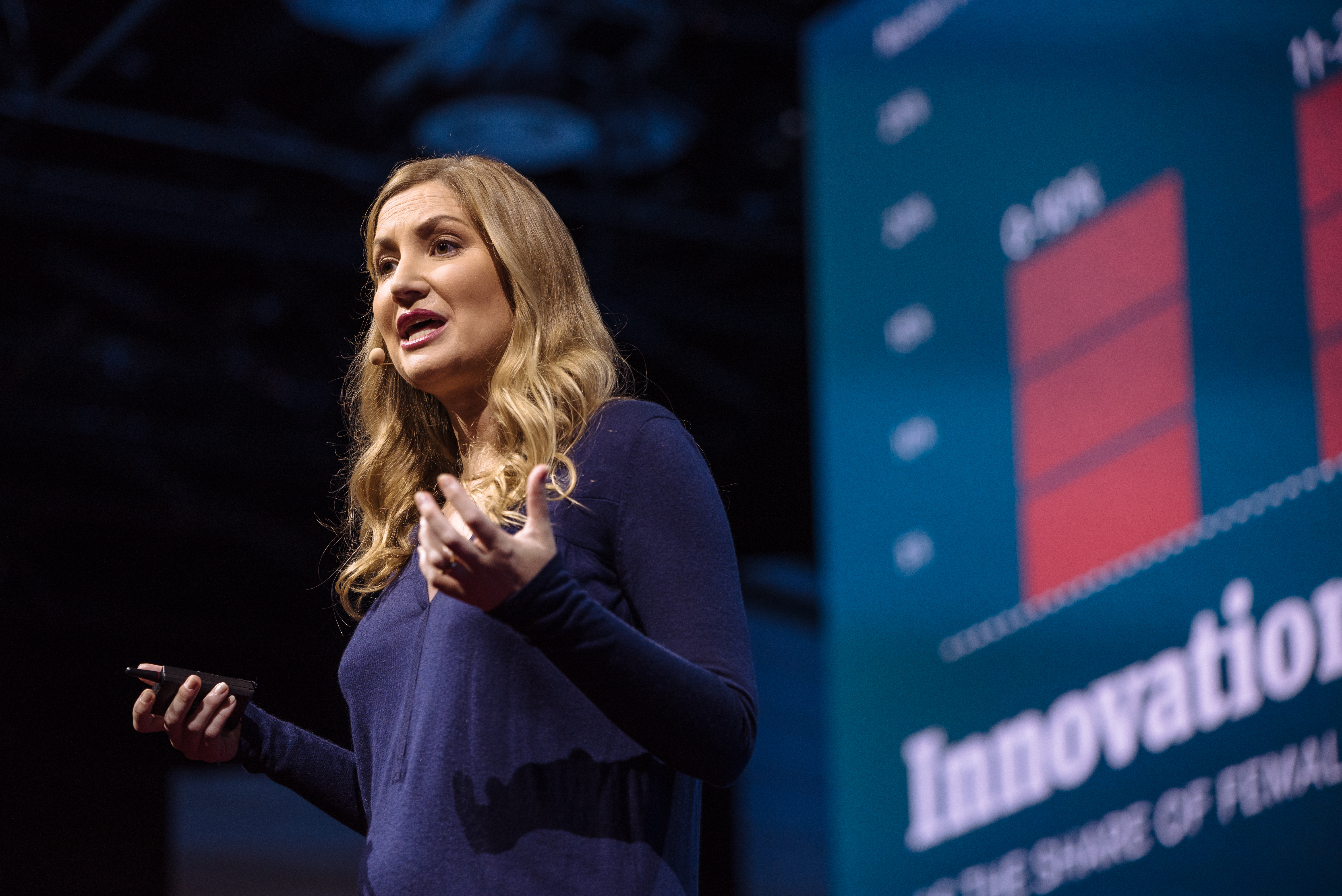
Are diverse companies smarter and more creative? You may think, instinctively, well of course they are … but Rocío Lorenzo and her team actually did the study to prove the effect is real. She speaks at TED@BCG in Milan. Photo: Richard Hadley / TED
Why diversity in the workplace is a competitive advantage. As a business advisor, Rocío Lorenzo noticed that the more diverse companies she worked with often produced fresher, more creative ideas than less diverse ones. So she wanted to know, was there a link? Were diverse companies really more innovative? Lorenzo and her team surveyed 171 companies from Germany, Austria and Switzerland to find out. At the onset of the study, she and her team doubted that they would find anything significant, but after the data came in, the answer was a clear yes. “More diverse companies are simply more innovative. Period,” she says. Since that study, Lorenzo has worked with many organizations who want to increase their innovation through strategic hiring and promotions, and she’s seen incredible results. How can your company follow suit? According to Lorenzo, who you hire and who you promote matter. Change the face of leadership and make it more diverse, she says, because diversity won’t happen naturally, and one woman in the boardroom won’t cut it.
Superheroes wanted. With great design power comes great problem-solving ability. “Design unlocks solutions to our problems,” says design champion Kevin Bethune. “I believe that design is not just important but absolutely necessary to achieve success in business.” Bracketed by examples from the design world, his own company and his personal inspirations, Bethune reveals the four superpowers that all designers possess: x-ray vision (understanding the implicit behaviors of people ), shapeshifting (emulating behavior of their subjects and turning feelings into products and services), extrasensory perception, or ESP (tapping into people’s senses) and the ability to make others superhuman (guiding people into a state of flow). Don’t believe it? Give designers room to truly thrive in the workplace and see firsthand what happens when these powers are released.
Humans and bacteria: an unlikely partnership. When it comes to decreasing our fossil-fuel dependence, we need to think beyond just how we power our homes and businesses. Nearly all the products we use today, including things like the fabric in our clothes, rely on petroleum and require huge amounts of water. Natsai Audrey Chieza, founder and creative director of R&D studio Faber Futures, is inventing new ways to engineer the things we want and need by fusing biology, technology and design. Consider fermentation, which she calls an “advanced technological toolkit for our survival.” Humans have long used this bacterial process to create things like cheese and beer; in the 1920s, Alexander Fleming employed it to create penicillin. After Chieza noticed the bacterial strain streptomyces coelicolor produces striking pigments, she harnessed it to dye textiles. The resulting fabric is colorfast and chemical-free (bonus: the process takes very little water). Chieza is now trying to scale up her methods, but what excites her most are the similar efforts that are underway in other labs and design studios. One startup is making “leather” from mushrooms, while another is using yeast to create a protein-based, super-strong yarn. The possibilities represented by such bio-based industries are both thrilling and dizzying, and we need to think about how we can best build, distribute and regulate them. As she says: “This is the material future that we must be bold enough to shape.”
The most mysterious microbes on earth. How deep can we go into the earth and find a living thing? We still don’t know the answer to this very basic question about life, says microbiologist Karen Lloyd. But in the early 2000s, scientists discovered living microbes buried in mud deep in the seafloor. “They’re not like anything we’ve seen before,” Lloyd says, which makes them extremely tricky to study. No one has even managed to grow them in a petri dish. “Those microbes have a fundamentally different relationship with time and energy than we do,” she says, “but if we can continue to find creative ways to study them, then maybe we’ll finally understand what life — all of life — is like on Earth.”
How great ideas happen. “We have all probably wondered how great minds achieved what they achieved,” says physicist Vittorio Loretto, opening up Session 2. The more astonishing their feats, the more we assume that they’re geniuses and unlike us. But is that really true? Are advances like the ones made by Newton and Einstein achieved by great leaps or by something else? How do we really conceive of something new? As a possible answer, Loretto introduces the concept of the adjacent possible: everything that is one step away from what already exists. “You can achieve them through incremental modifications and recombinations of the existing material,” he says. The adjacent possible is continuously shaped by our actions and our choices, helping us push the boundaries of what’s possible: “Impossible missions might not be so impossible after all.”
Getting the most bang for your buck on R&D. No matter what sector you’re in, most good ideas exist outside your organization — and most bad ones too. It’s up to your internal experts to help tell the difference between the two, says innovation instigator Michael Ringel. Ringel and his team found that the biggest drivers for a company’s success in R&D are a mixture of three things: external innovation, having access to great scientific information and actually listening to the internal experts who dispense that data. It’s the lack of follow-through on the listening portion that often makes productivity elusive. Ringel suggests seriously contemplating (rather than ignoring) internal research, offering positive personal incentives — and embracing the spirit of collaboration to cultivate the best ideas.
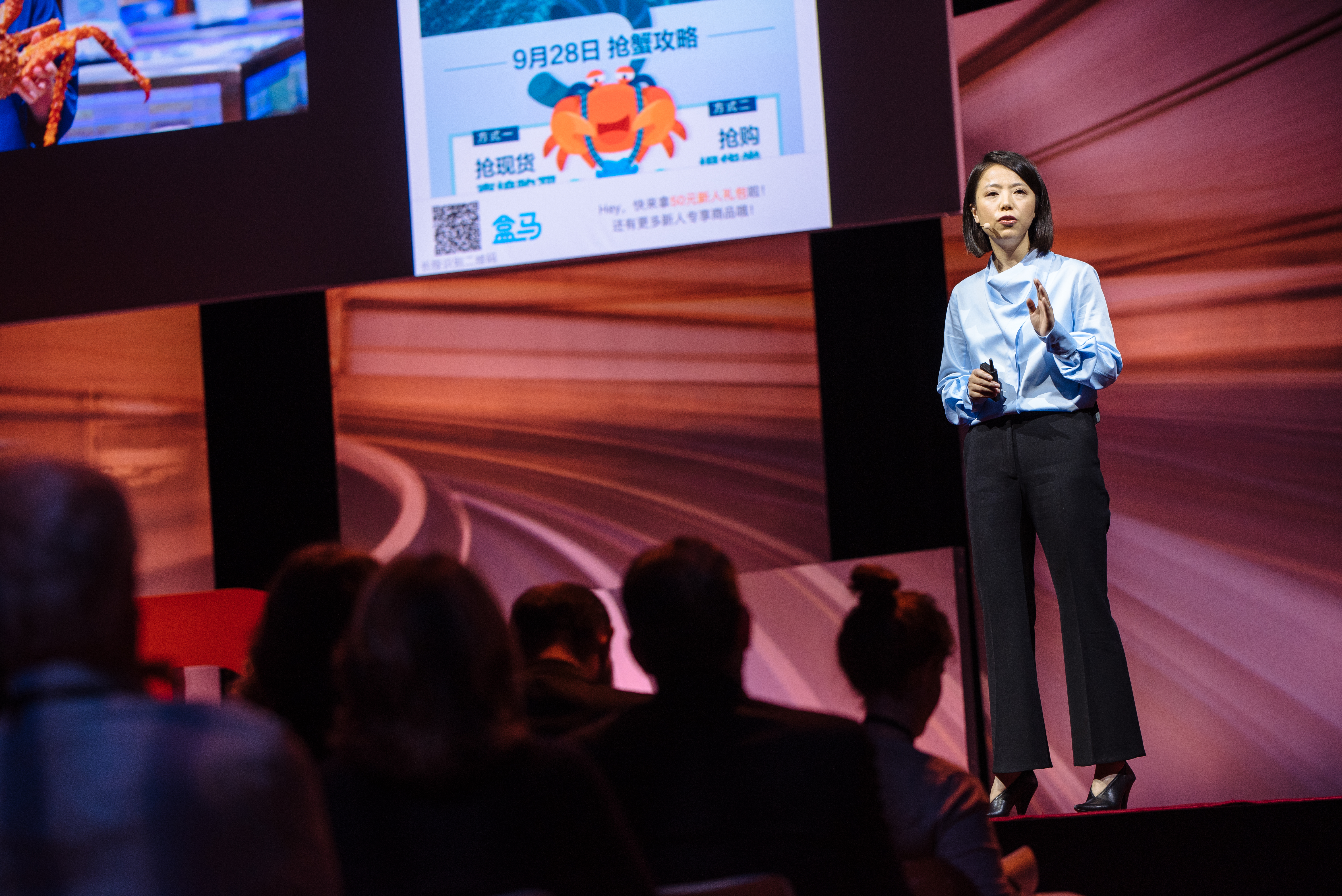
Where are people shopping in China? On their phones, says Angela Wang at TED@BCG in Milan. Photo: Richard Hadley / TED
The future of shopping? China, the world’s most populous country, is “like a huge laboratory generating all sorts of experiments and innovations,” says retail expert Angela Wang. And in this lab, everything is taking place on people’s phones. In China, 500 million customers — equal to the entire populations of the US, UK and Germany — are regularly making purchases via mobile platforms, where shopping and payment are seamlessly linked. Mobile payment is the norm even in brick-and-mortar stores. What should retailers know? People want shopping to be ultra-convenient (a Shanghai-based supermarket will deliver any of 4,000 items ordered via mobile to homes in 30 minutes), ultra-flexible (fashion retailers are responding to celebrity style and social postings by using “microstudios” to produce mini lines of a few dozen garments in 3-4 days) and ultra-social (shopping is embedded in social interactions, whether it’s customers sharing recommendations — and buying — via chat or the relationships that social influencers and 24/7 e-commerce shopping assistants are forging with customers). “We’re at the very beginning of a huge transformation,” says Wang, and this seismic shift in retail is reshaping not just the point of purchase but also supply chains, distribution and marketing. These rapid-fire, ongoing changes are the new business-as-usual, leaving retailers with a simple choice: adapt or die.
If you ever feel lost, stop and listen for your song. Music gives a soul to the universe and flight to the imagination, says student, musician and TED-Ed Clubs superstar Anika Paulson. Guitar in hand, she plays through the beats of her life, exploring how music connects us and makes us what we are — and how it can help us find our rhythm when we’ve lost it. “Where music has rhythm, we have routines and habits, things that help us remember what to do and how to stay on track,” Paulson says, strumming her guitar. Friends and family create harmonic structure in your life, and you’re the melody, she continues. In times of change, the new and off-tempo noises that enter your life might change your melody, but it’s still the same song — your song. “Music is my way of coping with the changes in my life,” Paulson says in a new movement of her song. “It changes and it builds and it diminishes, but it’s always there, surrounding us, connecting us to each other and showing us the beauty of the universe.”
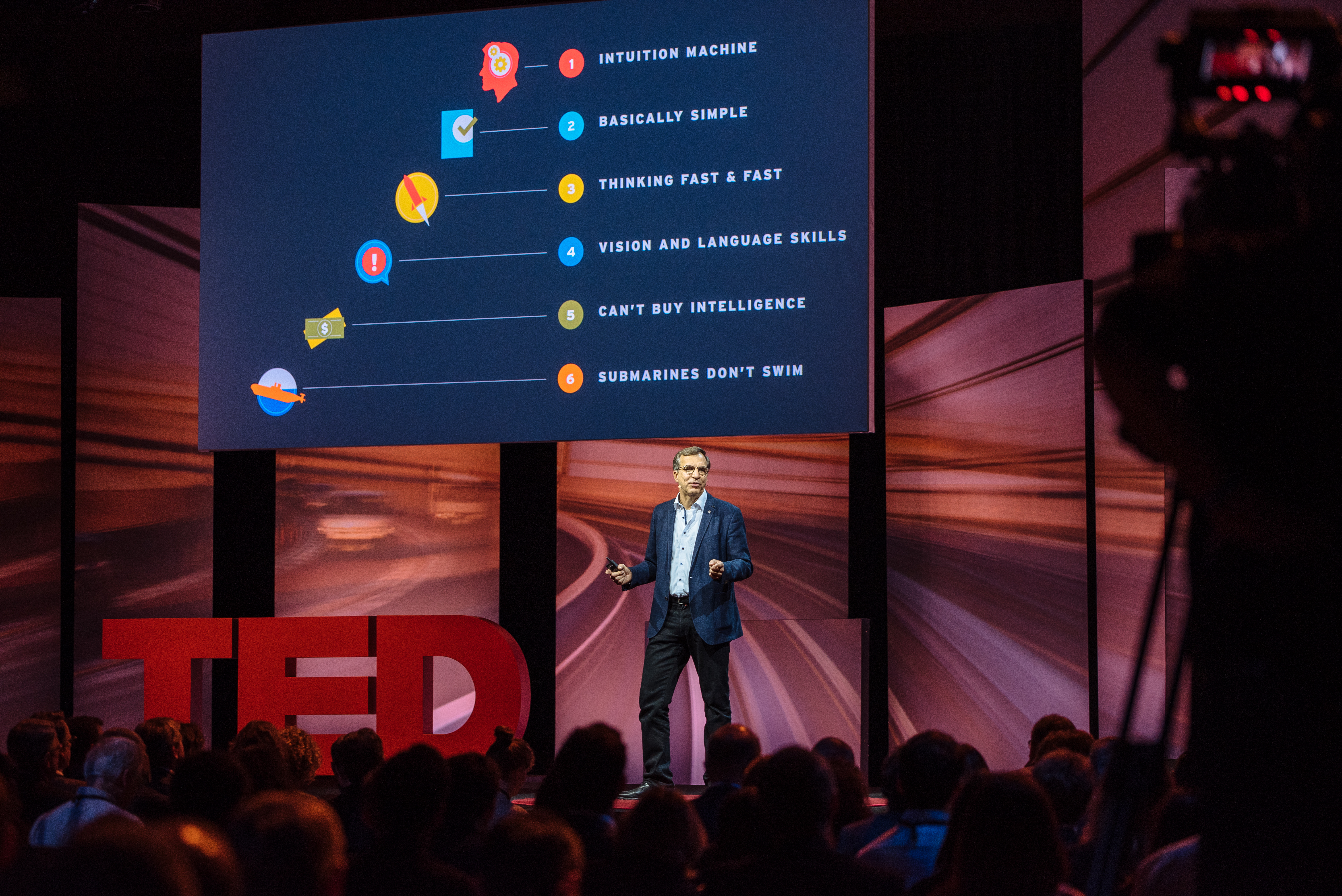
Philipp Gerbert tells us what’s next in AI at TED@BCG in Milan. Photo: Richard Hadley / TED
AI in practice. AI isn’t an abstract, mysterious force for experts only; instead, it’s for all of us to use and benefit from, says AI pathfinder Philipp Gerbert. The basic principles of AI are actually rather simple, Gerbet says: today, AI is a fast intuition and calculation machine with improving vision and language skills, whose intelligence we need to nurture with lots of data and feedback. And it solves problems really differently from the way a human might. It doesn’t just help on major, complex applications like self-driving cars; it can help with everyday tasks as well, Gerbert says. “When people — and by that I mean all us — start applying their knowledge of AI, we have seen the applications explode,” he says. If you’re working on tasks from translation to recruiting to cyber security and much more, you could use an AI assistant. “AI is not this destructive, mysterious force,” he concludes. “With this understanding, we can start moving from mere spectators, or prey, to becoming actors in the AI world.”
The danger of AI bias. As a research scientist at Google, Margaret Mitchell works on helping computers talk about what they see and understand. One day, she showed a computer an image of a house burning down, and the computer remarked on what a spectacular view it was. “I realized that as I worked on improving AI task by task, data set by data set, I was creating massive gaps, holes and blind spots in what it could understand,” she says, “and while doing so, I was creating all kinds of biases.” She realized that we need to think deeply about how the technology we create today will look in the future. “We can be proactive around the outcomes of AI and begin tracing out the evolutionary path that we’d like it to follow,” she says. But this isn’t something that only large tech companies can contribute to. “The math, the models, the basic building blocks of artificial intelligence are something that we can all access and work with,” she says. “We have open-source tools for machine learning and intelligence that we can contribute to.” We can also start a conversation about technology — what concerns and excites us, what aspects could be more beneficial or more problematic as time goes on. “If we want AI to evolve in a way that helps humans, then we need to define the goals and strategies that enable that path now,” she concludes.
Krumping to Mozart. Krumping is a free, expressive, exaggerated street dance that originated in African American communities in Los Angeles and has evolved into a global art form. Opening Session 3, French artist Wolf escaped into what felt like a moment of spiritual transcendence onstage, as he krumped with exacting precision to the “Lacrimosa” from Mozart’s Requiem aeternam.
A new paradigm of social responsibility. How can we make lasting and significant progress on the big challenges in our world? We need business to drive the solutions, says social impact strategist Wendy Woods. CSR, or corporate social responsibility, is the norm today — but it’s not strong or durable enough to drive solutions, she suggests, because it’s an incremental cost — and it’s almost always the first thing to be cut in bad times. Woods has a new paradigm: TSI, or total societal impact. “It’s the sum of all of the ways a business can affect society by thinking about their product design, manufacturing and distribution,” she explains. “And it can actually create core business benefits while solving meaningful societal problems.” That is, companies that perform strongly on social and environmental areas do better in the long run. Sharing new data from a study that looked at the companies that have done well on TSI, Woods shows how companies across industries like oil and gas, pharmaceuticals and banking see better margins and valuations when they do positive things like minimizing their impact on the environment and maintaining strong occupational safety programs. “One of the best ways for businesses to help ensure their own growth and longevity is to meet some of the hardest challenges in our society, and to do so profitably,” Woods concludes.
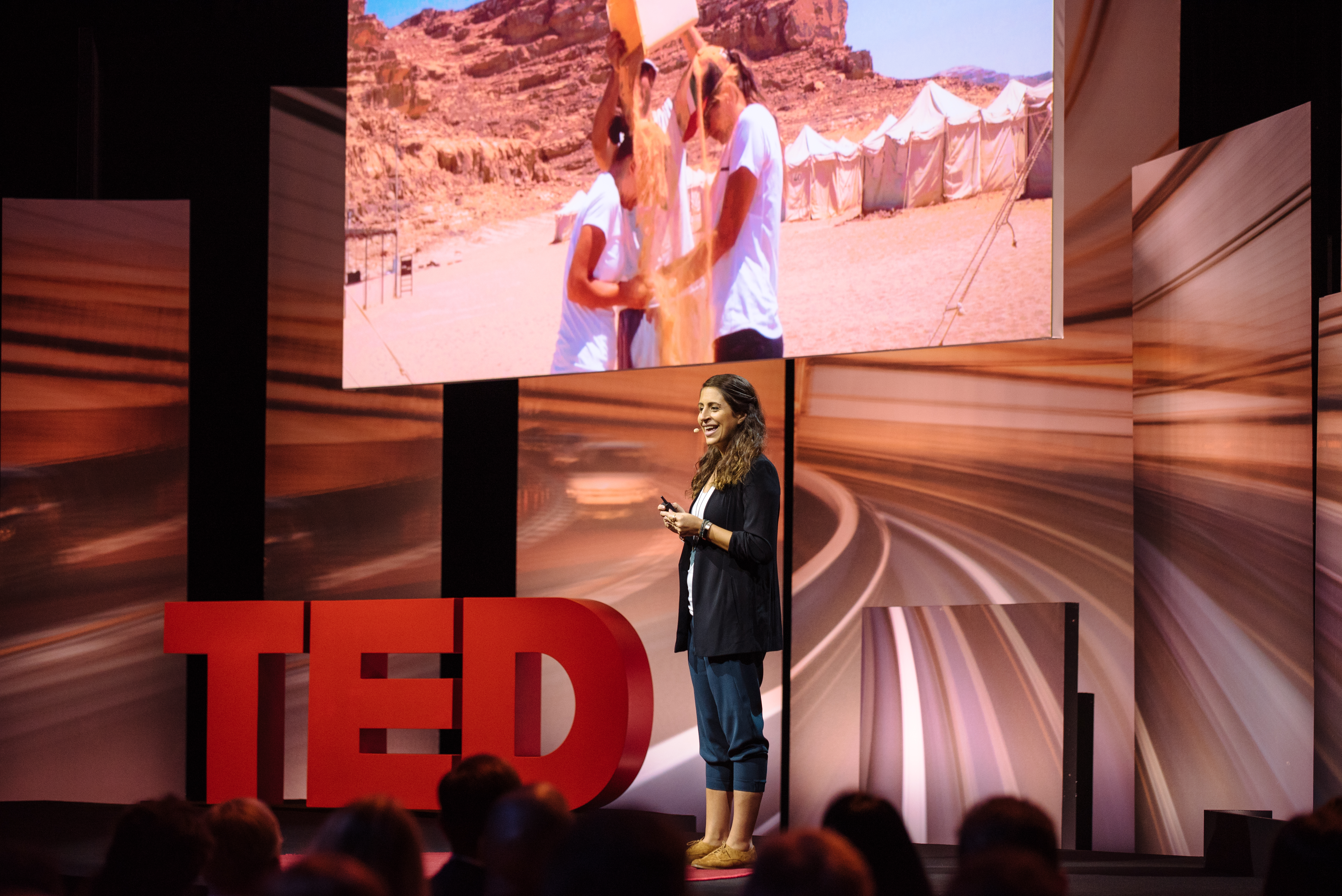
How do you do the Ice Bucket Challenge in a desert country? With a bucket full of sand, says Lana Mazahreh as she speaks to the world’s evolving water crisis at TED@BCG in Milan. Photo: Richard Hadley / TED
Hopeful solutions to the water crisis. According to the Food and Agriculture Organization of the United Nations, today nearly one in three people live in a country that is facing a water crisis. Water conservation activist Lana Mazahreh grew up in Jordan, a parched country that has experienced absolute water scarcity since 1973, and she learned how to conserve water as soon as she was old enough to learn how to write her name. What can the rest of the world learn from parched countries on how to save water and address what’s fast becoming a global crisis? Mazahreh shares three lessons from how water-poor countries have survived and thrived: Tell people how much water they really have, so they can take responsibility; empower people to save water, with simple tools like tap and showerhead regulators and toolkits with water-saving techniques; and look below the surface for water savings in unexpected places, such as in Australia, where they’re recycling wastewater. “If we just look at what water-poor countries have done, the solutions are out there,” Mazahreh says. “Now it’s really just up to all of us to take action.”
“Good” and “bad” are often incomplete stories. When we describe events as “good” or “bad,” we dilute the complexity of the human experience, says writer Heather Lanier. After her daughter was diagnosed with Wolf-Hirschhorn syndrome, a genetic condition that results in developmental delays, Lanier soon came to realize that a short-sighted perspective diminished what it means to live a full life — especially when it comes to individuals with physical and mental disabilities, who are often stripped of being seen as multidimensional people. “When we label people as tragic or angelic, bad or good, we rob them of their humanity, along with not only the messiness and complexity that come with it, but the rights and dignities as well,” she says. Instead of fixating on pity or attempting to normalize things, we should question the cultural values used to mark success and failure in life. Lanier takes life as it comes and watches her daughter’s life unfold for what it is — beautiful, complicated, joyful, hard — and responds to every new experience with the words from an ancient parable: “Good or bad, hard to say.”
The global learning crisis — and what to do about it. We are in the midst of a learning crisis, says Amel Karboul, education pioneer, Secretary-General of MEF (Maghreb Economic Forum) and Commissioner at the Education Commission. Globally, a quarter billion of the world’s children are out of school, and an additional 330 million are in school but failing to learn. If nothing changes, that number will only grow, but it doesn’t have to be this way. Karboul shares two important ways we can improve our education systems so that every child is in school and learning within just one generation: have countries learn from others within their same income level, and divide teaching between content teachers and tutoring teachers. We can implement these ideas worldwide by bringing stakeholders together, relentlessly following up to make sure progress is happening and finding new ways for countries to borrow money for education, Karboul says. “Education is the human rights struggle of our generation,” she concludes, “Quality education for all: that’s the freedom fight we’ve got to win.”
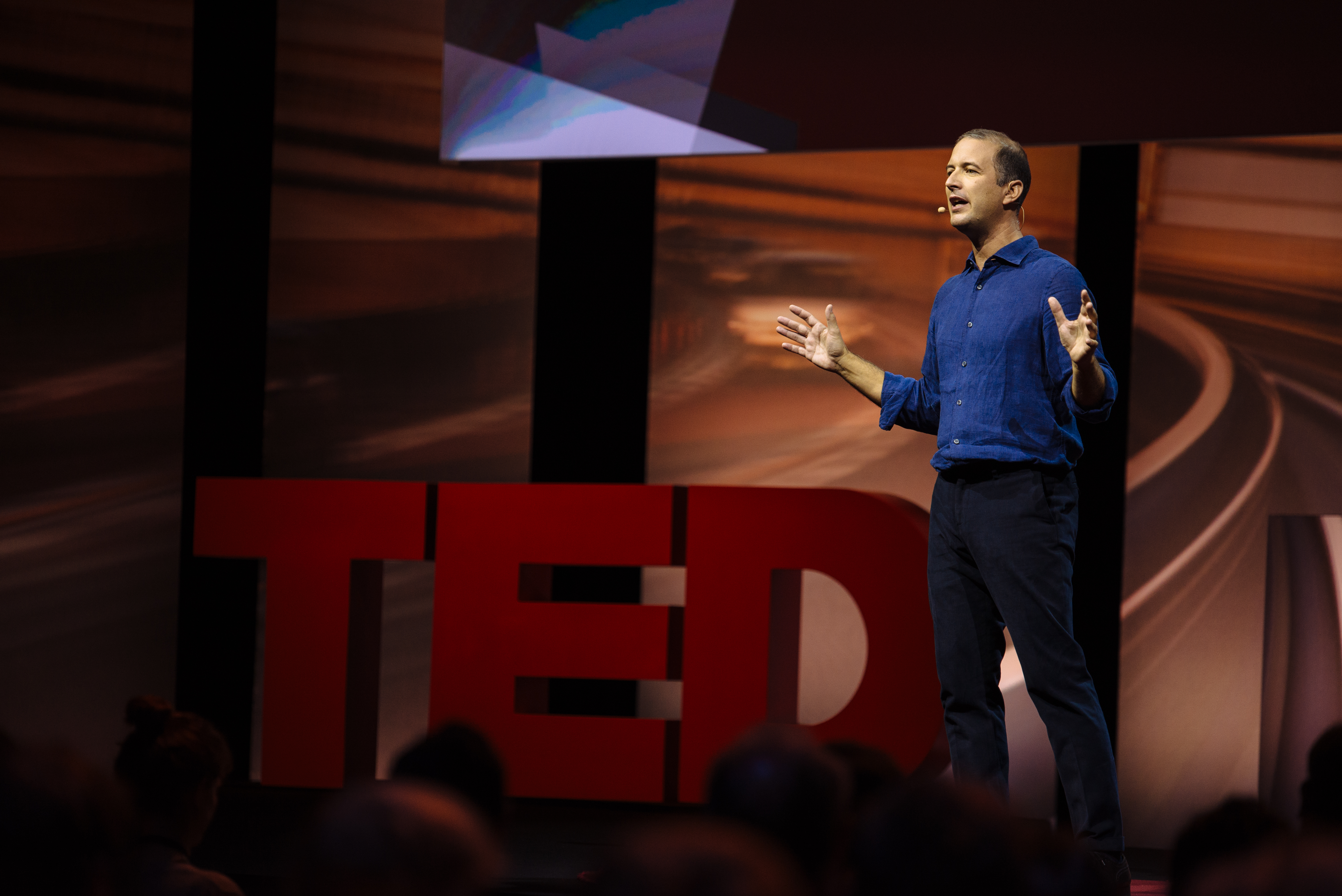
Unfairness can make a workplace into an unhappy place, says Marco Alverà at TED@BCG in Milan. Photo: Richard Hadley / TED
How to promote a fair workplace. What is it about unfairness? Whether it’s not being invited to a friend’s wedding (when other people who barely know her are) or getting reprimanded for an honest mistake, unfairness often makes us so upset that we can’t think straight. But unfairness isn’t just a personal issue; it’s also bad news for business, says Marco Alverà, CEO of Italian natural gas infrastructure company Snam. As Alverà explains, partial treatment or unwarranted penalties in the workplace often make workers unhappy and unengaged, leading to millions lost in productivity each year. So how do you promote a fair workplace? Alverà explains that organizations can create a culture of fairness by rewarding employees for doing what they feel is right, instead of what’s selfish or quick. In a brief interview following the talk, he offers a final tip for the rest of us: “You know what’s right — go for it!”